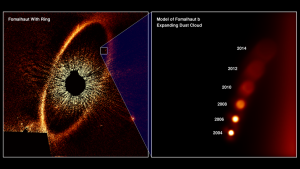
In what may be the first sign of life detected beyond our Solar System, the James Webb Telescope has detected the signature of a chemical compound that is known to only be produced by biological organisms, in the atmosphere of an exoplanet 124 light years from Earth.
Although its detection is still tentative, the spectral signature of the compound in question, dimethyl sulfide, was detected by JWST’s spectrographic sensors in the atmosphere of K2-18b as the exoplanet transited across the face of its host star. On Earth, dimethyl sulfide is only produced by biological processes, chiefly by marine phytoplankton, with smaller amounts being produced by other forms of bacteria; this means that, provided its presence on the distant world is confirmed, a photosynthesizing lifeform may be thriving on K2-18b.
K2-18b itself is a Neptune-like planet 2.6 times the size of Earth that orbits a red dwarf star found in the constellation Leo; the exoplanet was originally found by the Kepler Space Telescope in 2015, and although it’s orbit is less than half the distance Mercury is from the Sun, K2-18b lies in its host star’s Goldilocks zone, meaning that water can exist as a liquid on the planet’s surface.
What’s more, K2-18b’s spectral profile does indeed show the presence of water vapor in its atmosphere; the presence of carbon dioxide and methane, along with relatively little ammonia, suggests that the planet may have a liquid ocean. Along with its hydrogen-based atmosphere, the presence of a liquid ocean would make K2-18b what is called a “Hycean planet” (a portmanteau of “hydrogen” and “ocean”), two factors that could make such planets favorable for supporting life.
“Our findings underscore the importance of considering diverse habitable environments in the search for life elsewhere,” explained study lead Nikku Madhusudhan, an astronomer at the University of Cambridge. “Traditionally, the search for life on exoplanets has focused primarily on smaller rocky planets, but the larger Hycean worlds are significantly more conducive to atmospheric observations.”
Although there is the possibility that dimethyl sulphide could be produced by non-biological means, science is currently unaware of any such process, leaving a biological origin as the only suspected source for what has been detected in K2-18b’s atmosphere. The surface of the planet’s host star is also much more active than that of our Sun, potentially exposing K2-18b to high-energy radiation, such as x-rays, that could potentially sterilize the surface of any lifeforms. However, that isn’t to say that the planet mightn’t have some method of shielding its atmosphere and surface from deadly radiation, such as a robust magnetic field.
The discovery of this biological marker is also significant because mini-Neptunes like K2-18b seem to be fairly common throughout the galaxy, meaning there could potentially be a large pool of non-terrestrial planets that could be home to different lifeforms.
Subscribers, to watch the subscriber version of the video, first log in then click on Dreamland Subscriber-Only Video Podcast link.